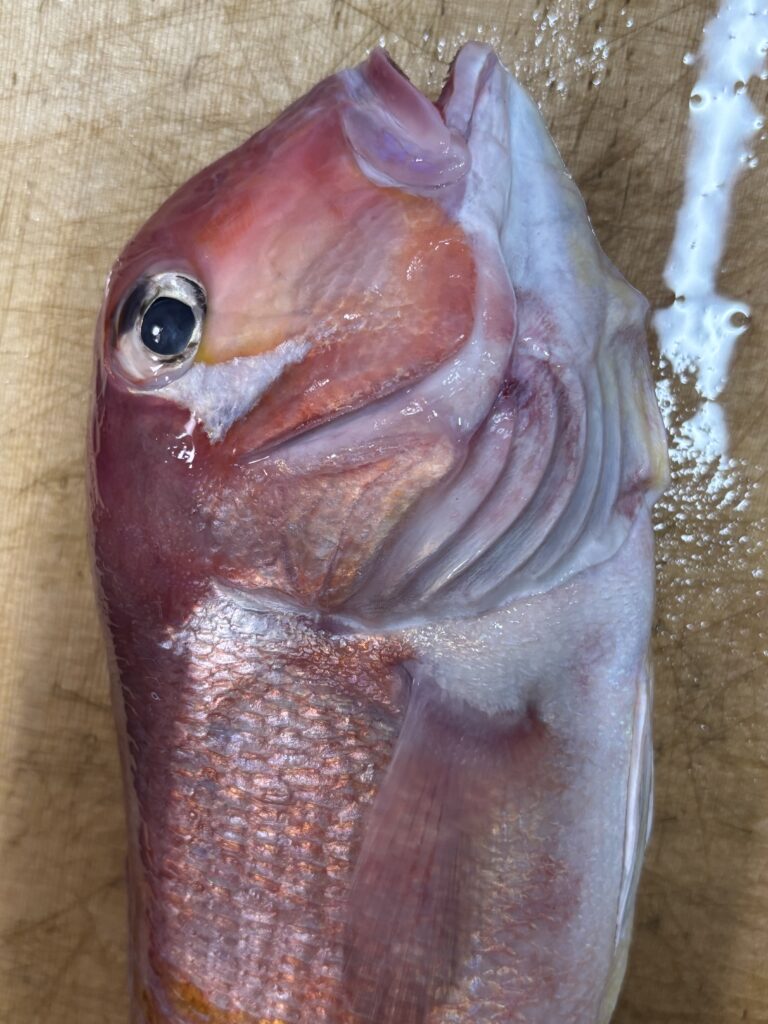
Contents
What Does “Tilefish” Mean?
“Tilefish” refers to a group of deep-sea fish belonging to the family Malacanthidae. In Japanese, they are commonly called アマダイ (amadai). The term may refer to various species, such as golden tilefish, blueline tilefish, or Japanese tilefish like Aka Amadai (Red Tilefish).
Scientific Classification of Tilefish
- Kingdom: Animalia
- Phylum: Chordata
- Class: Actinopterygii
- Order: Perciformes
- Family: Malacanthidae
- Genus: Caulolatilus, Branchiostegus, etc.
Common Types of Tilefish
- Golden Tilefish – Lopholatilus chamaeleonticeps
- Blueline Tilefish – Caulolatilus microps
- Japanese Tilefish – Branchiostegus japonicus a.k.a. Amadai
Habitat and Fishing
Tilefish inhabit the outer continental shelf and slopes, living near sandy or rocky bottoms at depths of 30 to 250 meters (98–774 feet). They burrow into sand or hide among rocks and crevices. U.S. fisheries manage tilefish through quotas, size limits, and seasonal restrictions.
Tilefish in Japanese Cuisine
In Japan, tilefish (amadai) is a luxury fish often served in high-end kaiseki meals, grilled with crispy skin, steamed, or used in sushi such as “Akamadai no Sugatazukuri” (whole red tilefish sashimi). The prized variety “Wakasa Guji” from Fukui is a regional delicacy.
Matsukasayaki
Matsukasa-yaki literally means “pinecone grill.”
It’s a traditional Japanese grilling method where the fish is cooked with the scales on, causing them to stand up and crisp like the layers of a pinecone.
The result is a visually stunning dish with crispy skin, puffed-up scales, and tender, juicy flesh.
Often used for prized fish like tilefish (amadai) or alfonsino (kinmedai), this method is a highlight in kaiseki cuisine.
Health and Nutrition of Tilefish
Tilefish are rich in protein and omega-3 fatty acids, though certain species (like golden tilefish) can have high mercury content. Always check local advisories before frequent consumption.
English and Japanese Usage of “Tilefish”
- Tilefish = アマダイ(general term)
- Red Tilefish = アカアマダイ (Akamadai)
- Japanese Tilefish = 和名:キツネアマダイ科の一種
FAQs About Tilefish
- Q: Is tilefish the same as snapper?
- A: No, tilefish and snappers are different species with distinct families.
- Q: Can I eat tilefish raw?
- A: Yes, especially in Japan, tilefish is often served as sashimi after careful preparation.
- Q: Are all tilefish safe to eat?
- A: Some tilefish, like golden tilefish, may contain high mercury levels. Moderation is advised.
Closing
Although sweet tilefish (amadai) wasn’t in season,
the sashimi was so incredibly delicious,
it felt like something out of this world—
so I’m jotting this down as a kind of personal note.
I served the fillets as sashimi,
and grilled the collar with salt.
The one I bought had rather large scales,
so I removed them carefully with tweezers.
The skin was lightly seared using the yubiki (hot water blanching) method—
which really brought out the umami.
When grilled, the fish was so fresh
even the fins stood up stiff and proud (cue: internal screaming).
To say it was amazing would be an understatement.
It was absolutely divine.
Although red tilefish (amadai) wasn’t in season,
the sashimi was so incredibly delicious,
it felt like something out of this world—
so I’m jotting this down as a kind of personal note.
I served the fillets as sashimi,
and grilled the collar with salt.
The one I bought had rather large scales,
so I removed them carefully with tweezers.
The skin was lightly seared using the yubiki (hot water blanching) method—
which really brought out the umami.
When grilled, the fish was so fresh
even the fins stood up stiff and proud (cue: internal screaming).
To say it was amazing would be an understatement.
It was absolutely divine.
